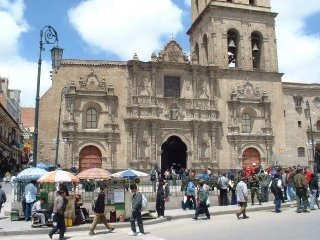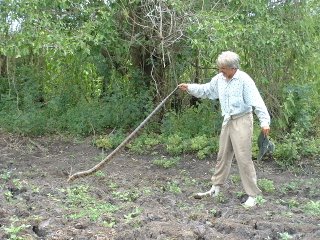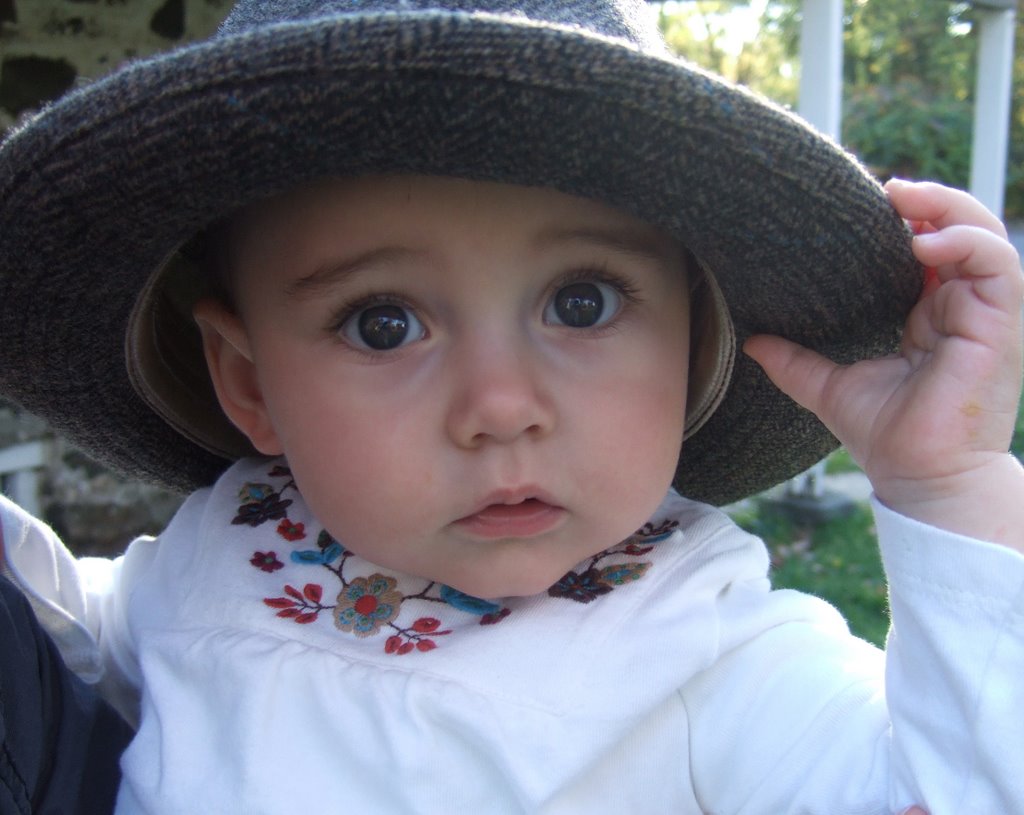La Paz to Rurrenbaque

To all our dear friends and family,
Firstly, I have to thank all of you for your special birthday wishes. I was definitely suffering mixed feelings about turning 3-0, and being so far away from 'home'. I was genuinely touched by Dan's surprise email party and the personal messages. I plan on writing back to everyone individually (this might take a little time!).
Now, on to the stories....
La Paz is awesome. We were on a bus from Cochabamba, driving a pretty straight line through the treeless, dry antiplano, passing the occasional campesino and his flock of llama, when the horizon suddenly dropped to reveal a deep canyon of densely packed, lego-like square buildings, randomly clinging to the hillsides and valley floor. Fringing the city's rim were mammoth, glowing, snow-peaked mountains, like Huayna Potosi and the triple-peak of Illimani. This incredible introduction to La Paz, made this city's comparisons to other scenic places, like Rio de Janeiro, San Francisco, Hong Kong, etc.. immediately understandable.
Once situated in our hotel along 'gringo alley' we were able to further explore the maze-like narrow, winding streets that are always climbing or descending a hill. The streets are full of indigenous people decked out in full chola regalia, mixed with more Western looking Bolivians in jeans or suits. The cramped buildings display a mix of architecture from modern sky-scrapers to colonial buildings on cobble-stone lanes. The sidewalks are crowded with vendors selling everything from textiles, saltenas, toiletries, to woven finger puppets. There is almost too much to see, that we had to be careful not to become distracted and risk petty theft. Our days were spent visiting the occasional museum (one on musical instruments was Dan's favorite), sampling varied cuisine and doing a LOT of shopping in the wild markets. The most interesting is the Mercado de los Brujas (witch market), where you can buy Pachamama (mother earth) statues, spooky llama foetuses, herbal and folk remedies, amulets and charms. We now have a new, almost full bag to add to our already heavy load.
On my birthday, we woke up to a cloudy sky and headed out to the La Paz cemetery. For Todos Santos, the streets leading to this hillside graveyard were cordoned off from cars, and were full of locals on their pilgrimage to pay respect to their ancestors. At the entrance was a flower market, and displays/offerings of baked bread, candles, and other religious tokens. We wandered through aisles of stacked graves where the families rent glass-windowed compartments to display flowers, placards, ash remains and other mementos to the dead. When it started to rain, we rushed back to our hotel, where I started to suffer the beginning of a flu. My first time being really sick on this whole damn trip, and it had to be on my 30th! I ventured out for a peek at my email - a total surprise - and was happily teary-eyed. Back to bed, where Dan nursed me and fed me B-day cake. The next day, both of us were sick, but thankfully recovered in time for our pre-booked departure....
A-VEN-TU-RA!!!! We joined Gravity tours for a 5 hour, hair-raising bike ride from La Cumbre to Coroico. This is a downhill journey on the World's Most Dangerous Road, which is only wide enough for one lane of traffic, has a series of blind curves, is unpaved, and skirts a mountainside with a 90 degree dropoff (no rails). This route has gained its' title because one bus or truck tends to fatally run-off the cliff every week. We figured that we'd have more personal control over our safety with the bikes. Most of the journey is in the high, misty, Yungas rainforest. Needless to say, the road is extremely muddy and wet, with random waterfalls cascading onto the road. There were around 15 people on our tour, with two exceptional guides, and we were all covered from head to toe in mud. We stopped several times along the highway to regroup and tighten those extremely important brakes (I rode them the entire way!). When two vehicles from opposing directions come toward eachother, the car going downhill must yield, by backing up to the nearest shoulder. This can create a huge traffic jam, depending on the amount of trucks and buses at the same point, and is extremely dangerous. With a little luck, everyone made it to the final destination without a single scrape. From here, we hopped into the back of a truck for the final miles to beautiful Coroico. This town is perched on a hilltop with the most breathtaking views of the lush, tropical Yungas - a vista of canyons, cloud-ringed mountain peaks, and farms of coffee and coca. We were with a great crew of travelers who all decided to stay at the Esmerelda Hotel. An incredible place, uphill from the town center with awesome views of Coroico and the regions deep green vegetation, a sauna for those sore muscles, a pool, volleyball net, billiards table, restaurant, bar, and movie center. This was the perfect place to 'veg', and that is what we proceeded to do for the next day. We only minimally explored the town, and prefered to read our books by the poolside, drink cold beer, and share an excellent French dinner with a large group of new friends at the local bistro.
----------------
Our next stop was Rurrenbaque, 15 hours away, in the heart of the Amazon basin. 'Rurre' is a humid, leafy, riverside town where the locals carry umbrellas to protect themselves from the sun, and all meals are eaten outside, on shaded patios. Dan and I had hooked up with Jackie and Adi, 2 Australians we met on the Gravity Tour. Together, we booked a 3 day excursion to the Pampas - an absolute highlight of our trip in Bolivia. On the tour, we were joined by another Australian couple, Nena and Christopher, and Susana, a Dutch girl. We took a 3 hour jeep ride to Santa Rosa, where we met our guide, Efrain, and boarded a long wooden canoe-like boat for another 3 hour journey upriver to our campsite. This was amazing! We have never seen such a wealth of wildlife in one area. The river was teeming with animals, lounging on the banks, swimming in the murky brown river, or sitting in the trees and bushes. We saw hundreds of big turtles, usually resting on logs atop of eachother in tortuga chains, big parties of alligators and caiman, who'd sink in the water as our boat approached, enormous storks with white wingspans taller than humans, lazy capybaras munching on grass, toucans, blue kingfishers, and numerous other bird species. We stopped along the banks and pulled up to a tree, where we fed bananas to a ravenous, screeching colony of tiny yellow monkeys. A little later at a bend in the river, our guide slowed the boat down and circled until a grey and pink dolphin popped its nose out of the water! A dolphins presence means that there are no piranha, so we jumped into the lukewarm water to clean the sweat off our bodies and join the dolphin in a swim. We arrived to our campsite, full of excitement about all we had just seen, and went for a short hike through the pampas (savannah) grass to watch the sunset. After dinner, we grabbed our flashlights for a night time river excursion. We were in search of alligators and caiman, whose eyes shone an eery red in the dark of the night. Efrain spotted some young alligators on the bank, oared up, and jumped into the river with his barefeet. He quickly managed to catch two small alligators, which we carefully passed between us to observe them upclose and feel their amazing skin.
After a night sleeping under mosquito nets, listening to scurrying mice and howler monkeys, we began an amazing second day. We left early for a long hike through the hot Pampas. Thankfully, there was a lot of cloud coverage, so we weren't completely baked. We were entering the habitat of numerous snakes, many of them poisonous. The pampas are famous for their giant anaconda. Unfortunately, we were unable to catch a glimpse of this black constrictor, but did find its long, deep, s-like trail through a muddy swamp, as well as the paw prints of a jaguar. Two weeks earlier, there had been a grass fire, which had trapped and killed several alligators. This, along with a drought and toxic water supply meant that we passed several carcasses along the hike. The boys were thrilled by this opportunity to examine the bodies and loot them of a grand collection of alligator teeth! The ripping of jaws and tearing the pointy, sharp teeth out was a surprisingly jovial affair.

The hunt continued for a snake sighting, which was fulfilled. Across a marsh, Efrain spotted a coiled up snake. He motioned for us to quickly follow. In Dan's haste, he nearly stepped on a completely different gigantic cobra! Efrain instantly changed his course, and ran back through the muddy muck in fierce pursuit of the fleeing cobra, losing both of his shoes. He literally leaped onto the tail of the cobra and scrambled to his feet, swinging the cobra around the air. The captured cobra had been in the midst of eating another very poisonous snake, which managed to escape the grasp of his fangs and slithered off into the bush. The angry, disturbed cobra made several hissing attempts to strike at Efrain. It's neck was winged, and we were all stopped dead in our tracks. It was incredibly frightening, especially when we learned that the bite from this mature cobra kills a cow in seven paces. Once Efrain was confident that he had subdued the smake he held it high above his head (it was taller than his body), and posed for photos. We couldn't wait for him to let it go. After freeing the snake we continued in the directon of the originally spotted snake which was still tightly coiled. It turned out that this snake had recently been killed, most likely by a guide who had hit it too hard on its head. Efrain was saddened by this unnecessary killing - 'malo'. We were able to touch the pale yellow skin with dark brown rings and hold the still warm body of the snake, which was a little creepy. Bristling with adrenaline and amazement at all we had seen, we left the Pampas and headed back to our camp for a large lunch.
That afternoon, Efrain took us out on the boat to go piranha fishing. We put stinky, red meat on our hooks, and felt the fish nibbling within seconds. The water was teeming with piranha, but it was hard to actually hook and reel them in. Together, we managed to catch 4 purple, yellow, and grey irridescent piranha, which were going to play a role in our cena (dinner). We also caught a few sardines, which Efrain used to lure eagles closer to our boat. First, he would get their attention by making bird calls, then wave the fish high in the air and toss it into the river. The eagles would continually dive after their prey, grasping the fish with their talons. At the end of our 3 days in the pampas, we were thoroughly impressed with Efrain, his animal noises, and incredible knowledge of the native wildlife and flora, gained after 18 years of experience.
Back in Rurrenbaque, we decided to go on another excursion, this time to the Parque Madidi selva (jungle). Adi and Jackie were going on a 4 day trip, and we tagged along for the first 2 days. We felt that this would be sufficient time, since we had already visited much jungle in Bolivia. We coasted up the Madidi river on a 5 hour journey, arriving at our semi-sheltered jungle campamento. We lucked out with another amicable guide, named Jose Luis, and his wife, Flora, our camp cook. He was more than willing to adjust the daily program to whatever we desired. First stop - the ultra cool and clear swimming hole, where our body temperatures were lowered in the stifling heat. After that, the boys were determined to catch some fish. We hiked out to sandfly territory and tried our luck at the river's edge. Unfortunately for Dan and Adi, they kept getting their lines stuck in the rocks, which required stripping down and wading out to free the hooks. This meant that the two of them were covered in a myriad of nasty bites by the end of an unsuccessful fishing session.
At night, we went on a torchlit jungle trek to try and spot some uniquely nocturnal animals. We could definitely hear the monkeys, birds and insects (which is worthwhile), but it is extremely difficult to spot animals in the dense foliage during daytime, let alone at night. We did manage to spot a tree frog, which I thought was pretty cool. The next day, we went on a longer excurion and were able to spot 2 tejons, and another animal similar to a raccoon, but all black, and wild boar tracks. The best part about this hike was all the plants that Jose Luis showed us, teaching us about their special medicinal properties and uses for the indigenous (such as dyes, rheumatoid medicine, wood for BB shooting weapons and poison tipped spears, and the vines which can be cut for their pure water supply). Back at the camp, Jose Luis taught us how to make rings out of a jungle seed, polishing them to a rich black or brown with dirt and ash. We said our goodbyes to Adi and Jackie and headed back to 'Rurre' again.
Today, we avoided the return journey to La Paz on the World's Most Dangerous Road, by taking a 12 seater, hour long plane ride. This gave us our final bird's eye overview of the vast jungle, then over giant brown mountain peaks and small lakes to the high altitude antiplano. Back in the city for a short break, suffering minor altitude related headaches, we're planning our morning departure to Sorata.
We have all of our photos up to Cochabamba posted on the website, and will have the shots from La Paz to Rurrenbaque up in a few days. We also learned that a whole chunk of photos from our 4 day Uyuni tour had been missing from the website. We restored these shots, so please take a look, in case you missed them the first time.
http://www.pbase.com/dgsc/bolivia__la_paz_to_coroico and http://www.pbase.com/dgsc/bolrurr
Sending our best from far, far away,
Sarah and Daniel



0 Comments:
Post a Comment
<< Home